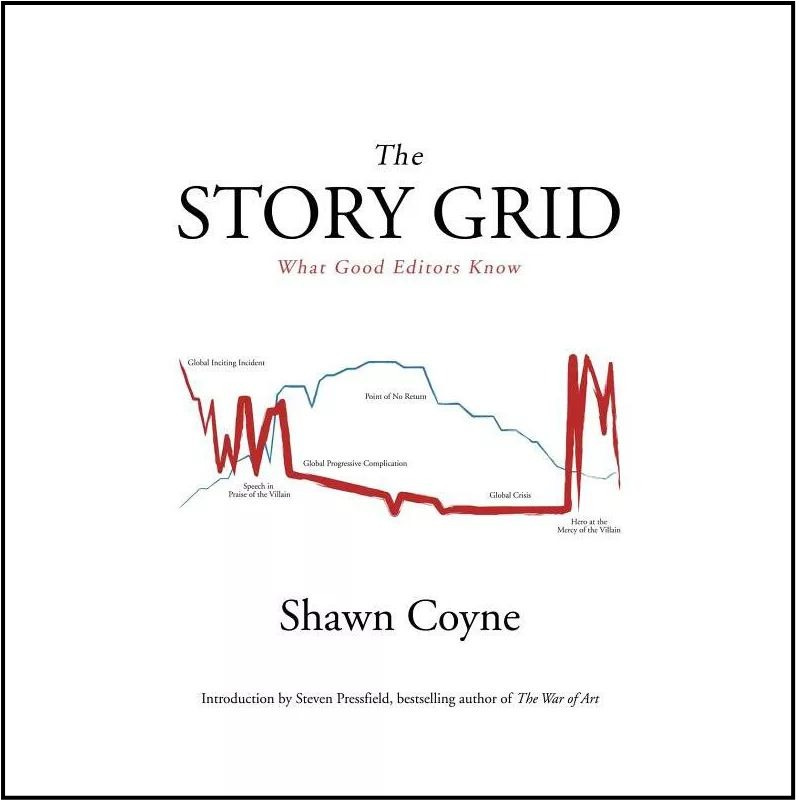This post is part of Art & Craft, my series that reviews books about writing books.
Shawn Coyne is an industry veteran–an editor for Big Five publishing houses, an independent publisher, a literary agent, a ghostwriter. He’s worked with dozens of best-selling authors and has coalesced his experience into The Story Grid. The title is both a craft book and a process which, he claims, can convert manuscripts into novels that “work.”
Why I chose this book
I first heard about this book from a recently debuted author at a World Fantasy con. He claimed it was his turning point from amateur to pro. This was an early title in my craft book journey, I devoured it in 2020 over two, lockdown-hazed days. Rereading it for this series, after subconsciously comparing many other titles, I find that it’s a different, almost quantitative method of perceiving your Work in Progress. But the method requires that you apply significant analysis to your draft, work you may not have anticipated. The obvious question… is it worth it?
The highlights
This is not a book about how to write
This is a book about how to edit.
Coyne’s premise is that all authors must learn to be their own editors, because professional editors just don’t edit like they used to. I’d love to hear takes on this from some current NY-based editors, but he claims: “These days if you’re lucky enough to get your book picked up by a major publisher… you may receive a few consultory e-mails. You may even get a three-page memo of “notes.” …It’s a hard fact of the twenty-first-century book biz that the writer, for all intents and purposes, has to be her own editor.” [sic] [page 3]
He also alleges that his Story Grid is one of the few (only?) formalized editing processes in the industry, one that can be taught and replicated. Many of my peers find this prescriptive–and it is. Coyne presents his approach with the rigidity of law and order, which many chaotic creatives find constricting. But I think he addresses this objection in the book’s conclusion:
“It’s my contention that most writers don’t fear the work. They want to do the work. No one, though, has clearly laid out in practical terms what exactly the work is. I built The Story Grid methodology to do exactly that… the problem that bedevils most novice writers (and even some seasoned pros) is that they fall in love with the glamorous aspects of the literary trade–the romance of ‘the creative process,’ the thrill of dashing off chapter after chapter in a white heat of inspiration, etc.–understanding and mastering Genre, Story form, character, Story cast, and so forth. They fail to learn how to edit.” [pages 332-333]
This is why the lens of “a book on how to edit” is crucial for approaching the Story Grid. While it could help you organize your thoughts during ideation, consider picking it up after the initial drafting and/or brainstorming is done. After you have gushed all your energy, ideas, and enthusiasm into your book, look to the Story Grid to make it make sense.
This is a book about Genre
More than any other concept, Coyne is obsessed with Genre (with a capital G, the way some people talk about God). He insists in no uncertain terms that you must decide your book’s Genre, and then fulfill its conventions and include its obligatory scenes.
And if you don’t? Apparently, your book will fail: “So what happens if I fail to deliver even just one of these obligatory scenes…? I haven’t written a mystery novel. I’ve written a book that doesn’t work.” [page 50]
If you need specifics, The Story Grid extensively describes these Genre expectations for thriller and mystery novels. Conventions of a mystery story include [page 47]: a body, an investigator, a watson, a prime suspect, and red herrings. Obligatory scenes are [page 50]: discovery of the body, confrontation of the murderer, and the ultimate conclusion of justice or injustice. Given the amount of weight he places on this concept, I think he could have devoted more pages to describing the conventions and obligatory scenes for a broader list of popular genres (though he has provided more extensive resources on his website).
Coyne’s insistence on these scenes and tropes is founded in his definition of Genre: “a label that tells the reader/audience what to expect. Genres simply manage audience expectations.” [page 56] Many authors are dismissive of such labeling, but any story can be defined by some Genre (which Coyne has analyzed, categorized, and sub-categorized), and the pitching and marketing of your work will force you to place a Genre flag, or the flag will be placed for you. According to Coyne, you then have obligations due to the expectations of that Genre’s audience. For us artistic types who always want to break the box, the question is not just whether you can make a “new” or unconventional story work–it’s whether you can sell it, since you may need to introduce your work using entirely new language about what it is and why it works.
I’m confident we could debate this idea until AI has completely consumed the industry, but this is Coyne’s take, love it or leave it.
This is not a magic formula
So what is the Story Grid, literally? Coyne spends much of the book describing the ideas and necessary spreadsheets it in detail, but in summary it’s an inventory of all your scenes, labeled to make sure you’ve delivered on the expectations of Genre, annotated with their word count and other characteristics about the action and character development, which can be illustrated with a graph. It’s a detailed method to organize and analyze information about your book, which can help you make decisions about revisions.
One reason I appreciate this approach is that Coyne does not make “foolproof” false promises, or imply that success lies in plugging variables into Genre templates. This is a tool which requires creativity, talent, and sweat. And despite the haranguing about Genre obligations, I generally find his approach to be encouraging. He calls his method “a diagnostic tool and not a recipe,” insisting, “You as the writer are not the problem, the problem is the problem. The [Grid] will tell you where your problems are.” [pages 112-113]
The cringe
It feels like my gripes are many so I’ll keep them short and shaped as grains of salt.
Typos
I found many typos in my edition of the book, which is awkward for Coyne’s small publishing enterprise.
Filler
While the Story Grid method is a formalized process, The Story Grid craft book is prone to rambling tangents, especially in the first half. Coyne waxes poetic about the meaning of “story” and its role in the human psyche, and why authors are motivated to write. As if we didn’t already know.
Rx
The prescriptiveness I’ve already touched upon, and it’s reinforced by a section which outlines writing commandments. The advice seems solid, (i.e., thy story must have an inciting incident), but, given Coyne’s industry experience, I’m surprised he doesn’t recognize how his tone could turn us artistic types away. For example, in this section he claims:
“Knowing [Story elements] and trusting their efficacy are mandatory. A writer who does not pound these concepts into her head will never come close to reaching her artistic potential. There is no escaping them. And anyone who tells you differently is either ignorant or a charlatan. Seriously.” [pages 158-159]
Progress vs. perfection
Much of the text is devoted to using the Story Grid to break down The Silence of the Lambs by Thomas Harris, which Coyne also uses as an example to demonstrate POV, character, theme, and pacing (and I like that these ideas are presented in context, since most craft books approach these concepts with cold introductions via isolated chapters). Glossing over where Coyne fanboys too hard about this “perfect” novel, my gripe is that I believe it was a mistake to use a published novel as an example to teach the Story Grid. He passes on the opportunity to demonstrate what it looks like to use his method to actually revise a novel in progress–which is, you know, the whole point. Instead of saying, “and this how how I realized Client X’s book needed Y,” we get, “See how Thomas Harris is a genius? Look, the Story Grid for his book shows how well he nailed it.”
Lexicon
While I acknowledge Coyne’s experience in the industry and expertise as an editor, it’s important to recognize that the ideas he presents are still theoretical. For example, his Genre clover, which categorizes books based on five characteristics, is based on his analysis of this concept. This is not industry-standard language. The ideas are interesting, well-informed, and have lots of merit, but should not be mistaken for a universal interpretation.
Productive adjacency
And finally… if you are not a spreadsheet queen, if you are not a visual thinker, or, my greatest fear, if you are easily distracted by tasks which seem easy but are not actually productive, mapping out your novel in a Story Grid could actually be a waste of time. All craft books and writing processes should be viewed as suggestions. Trust yourself to identify what works for you, don’t be afraid to reject some processes or only use pieces, and be honest if what you’re doing is not actually positively shaping your manuscript.
Star-ratings
How useful is this craft book?
3 out of 3 stars - ★★★
How humble is this craft book?
2 out of 3 stars - ★★☆
How concise is this craft book?
2 out of 3 stars - ★★☆
Overall, yes, I think it’s worth it. Out of all the books I’ve read (and reread) for this series, this one has caused me to reflect most on my current novel project. I think what’s missing in my rough draft is a strong sense of the B plot which, per Coyne, should reflect the protagonist's internal desire [page 80]. I’ve been very focused on nailing the ending of the A plot, which is an area where I have been historically weak. So for all my ever-present gripes, this alone may be proof enough that I find this craft book helpful and worthwhile.






Jacob seems to be enamored with this book, but I found it plodding and extraordinarily time consuming to decipher. Genres are more fluid these days, and I think you are right, he needed to make the lists of mandatory scenes more obvious and easier to get to and understand. Thanks for your breakdown!